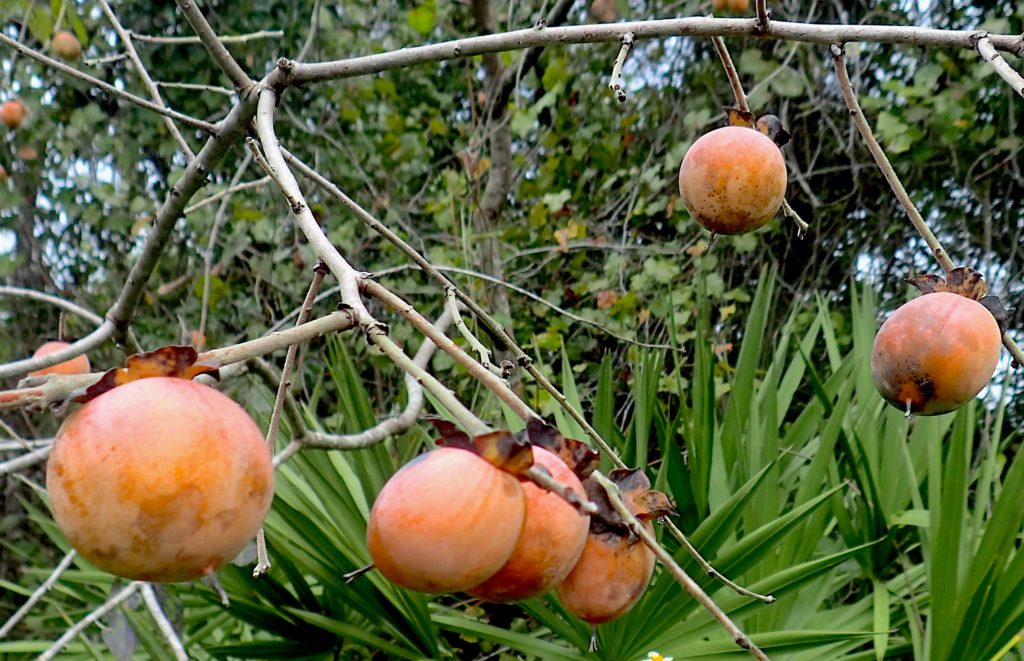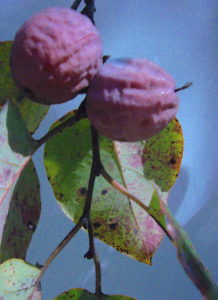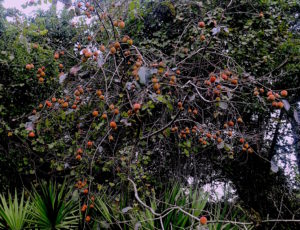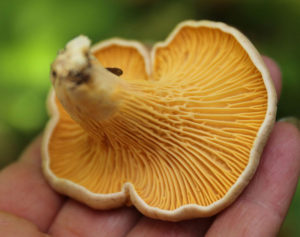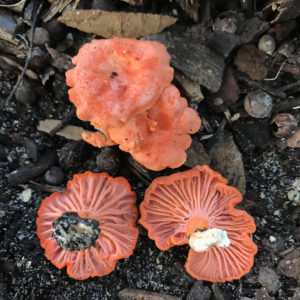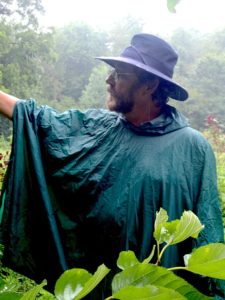What of persimmons? For years I looked for them to ripen in October, occasionally September. I could always be assured that by Columbus Day there were persimmons to be had. Last year they were late. I even found one tree ripening in January! On the West Orange County Bike Trail last week I ate two almost ripe persimmons — in early August! They had just a little after-consumption astringency. The grapes are early this year, why not persimmons?
Persimmons suffer from the same problem as the Indian Strawberry. When you hear “Indian Strawberry” you kind of eliminate the “Indian” part and hear “strawberry.” The fruit unfortunately does not live up to the word strawberry in any way except perhaps general appearance from a distance. Eating an Indian Strawberry is not like eating a real strawberry. If you’re thinking “strawberry” it’s a big let down. The problem persimmons have is oriental persimmons which are wildly cultivated. They are huge, sweet, nearly if not seedless, and not astringent. Wild persimmons are small, very seedy, and astringent until extremely ripe. This is cause for disappointment though it shouldn’t be. The astringency is part of the tree’s strategy. It does not want its fruit eaten until the seeds are ready to germinate. So the fruit stays non-palatable until the seeds are good to go then the fruit turns sweet. Also the tree wants only mammals that can taste sweetness to move the seeds around. Members of the cat family, for example, can’t taste sweet so they won’t eat persimmons. Bears and raccoons can taste sweet so persimmons are high on their menu.
In case you are wondering dogs, Canadian otters, red wolves, monkeys, apes, horses and humans can taste sweet among many. All felines, bottlenose dolphins, sea lions, harbor seals, spotted hyenas and Asian otters cannot. Generally speaking omnivores can taste sweet and strictly meat eaters usually do not. If you, for example, eat fish whole there is no reason for you to taste sweet whereas if you’re a fruit-eating bat sugar is important. Some animals can detect some forms of sugar — glucose, fructose, and sucrose — but not others such as galactose and lactose. Thus for some “sugar and spice” is not always nice.
Americans inherited a fear of mushrooms from the English. The English are still fungi-phobes but not Europe. A mushroom the British would call “oily” a Ukrainian would call “buttery.” My goal for several years has been to identify the six to one dozen really easy-to-learn local edible mushrooms. Among the easiest and also the tastiest are chanterelles. They can be found from about June to October, maybe even a bit longer than that, and are easy to find and identify. In fact the hardest thing about chanterelles is cleaning them. Ours tend to grow low, we have sandy soil, and rain splatters the grit and debris and chanterelles have a lot of places to collect grit. They don’t have “gills” per se but wrinkles and those wrinkles collect bits of sand and leaf litter. Brushing doesn’t work well — washing’s a no-no — so I’m trying out techniques with my air compressor.
Not only don’t chanterelles have gills but they have cross wrinkles, like little bridges between two shores. That gives one confidence when identifying them. And, the list grows. Recently a new chanterelle was named from Florida. We’ve had one species of pink to red chanterelle, Cantharellus cinnabarinus. I found some under a Hawthorn tree this week. But some pink to red ones are also found under Sea Grape trees. They got a new name, Cantharellus coccolobae (named after the Sea Grape genus) and they taste good, too.
Locally Chickasaw Plums are about done by June if not sooner. They are definitely a sweet wild edible found in the second quarter of the year. So when we saw a tree full of plums during our foraging class this past week in Ocala they could not be Chickasaws. Flatwood Plum is a better candidate. They fruit in the third quarter and I’ve seen fruit on them in late September. Alas, they are not as tasty or sweet as their cousins. In fact, even when ripe Flatwood Plums can be bitter or have a bitter aftertaste. This is why they were usually made into jelly. One telling sign was the tree we found in Ocala was not only was it ladened with fruit but the ground was covered as well. Non-sweet fruit doesn’t market well to the animal community. You can read more about wild plums here.
Upcoming Foraging Classes: This past week while foraging we found a wide variety of fruit and mushrooms to talk about. Though cultivated we saw pomegranates, pineapple guavas, avocados as well as wild grapes, creeping cucumbers, hackberries and four species of edible or wild mushrooms.
Sunday, August 27th, Florida State College, south campus, 11901 Beach Blvd., Jacksonville, 32246. 9 a.m.
Saturday, September 2nd, Boulware Springs Park, 3420 SE 15th St., Gainesville, FL 32641. 9 a.m.
For more information about the classes go here.
All of Green Deane’s videos available for free on You Tube. They do have ads on them so every time you watch a Green Deane video I get a quarter of one cent. Four views, one cent. Not exactly a large money-maker but it helps pays for this newsletter. If you want to see the videos without ads and some in slightly better quality you can order the DVD set. It is nine DVDs with 15 videos on each. Many people want their own copy of the videos or they have a slow service and its easier to order then to watch them on-line. They make a good gift for that forager you know. Individual DVDs can also be ordered. You can order them by clicking on the button on the top right of this page or you can go here.
Want to identify a plant? Looking for a foraging reference? Do you have a UFO, an Unidentified Flowering Object you want identified? On the Green Deane Forum we chat about foraging all year. And it’s not just about warm-weather plants or just North American flora. Many nations around the world share common weeds so there’s a lot to talk about. There’s also more than weeds. The reference section has information for foraging around the world. There are also articles on food preservation, and forgotten skills from making bows to fermenting food. One special section is “From the Frightening Mail Bag” where we learn from people’s mistakes. You can join the forum by clicking on the button on the upper right hand side of this page.
This is issue 270.
If you would like to donate to Eat The Weeds please click here.

